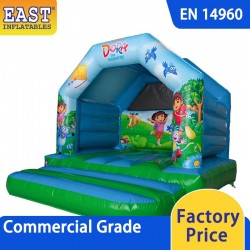
Bounce houses, also known as inflatable castles or moonwalks, can provide endless fun for children. However, it's essential to ensure that these play structures are safe environments for kids to enjoy. To prevent injuries while your child is playing in a bounce house, follow these safety guidelines:
Supervision is Key: Always assign a responsible adult to supervise children while they play in the bounce house. This person should actively monitor the children and enforce the rules to ensure everyone's safety.
Proper Setup: Make sure the bounce house is set up on a flat, level surface free of rocks, sticks, or other potential hazards. Follow the manufacturer's guidelines for inflation and anchoring to prevent tipping or collapsing.
Age-Appropriate Play: Only allow children of a similar age and size to play together. Older and larger children may accidentally injure smaller ones due to their size and energy.
Footwear Rules: Shoes, jewelry, glasses, and any sharp objects should be removed before entering the bounce house to prevent punctures and injuries.
Limit the Number of Children: Avoid overcrowding the bounce house. Follow the manufacturer's recommendations for the maximum number of children allowed to ensure everyone has enough space to bounce safely.
No Rough Play: Encourage children to play gently and avoid roughhousing, wrestling, or somersaults, which can lead to injuries.
No Climbing on Walls: Instruct children not to climb on the walls or netting of the bounce house, as this can cause it to tip over.
Observe Weight Limits: Follow the weight limits specified by the manufacturer. Overloading the bounce house can lead to structural failure and accidents.
Weather Conditions: Do not use the bounce house during inclement weather, including strong winds, rain, or lightning. Sudden gusts of wind can cause the bounce house to become airborne.
Secure Entry and Exit: Ensure there is a safe entry and exit point with a proper step for children to use when getting in and out of the bounce house. This can prevent tripping or falling accidents.
Regular Inspections: Check the bounce house for any signs of wear and tear, including tears, holes, or loose seams. Repair any damage promptly and do not use a damaged bounce house.
Staking and Tethers: Ensure that the bounce house is adequately staked and tethered to the ground to prevent it from moving or flipping.
Emergency Plan: Establish an emergency plan in case an accident occurs. The supervisor should know how to respond to injuries and have access to a first aid kit.
Limit Bouncing Time: Limit the time children spend in the bounce house to prevent overexertion and fatigue.
Deflate Properly: When it's time to deflate the bounce house, make sure it's done gradually and safely. Keep children away during the deflation process.
By following these guidelines, you can help ensure that your child and their friends have a safe and enjoyable experience in the bounce house. Remember, safety should always be a top priority when it comes to inflatable play structures.




Leave a Comment